Can Cross-Fostering Save This Once-Technically-Extinct Species?
Pocosin is a loanword from Eastern Algonquian, meaning “swamp on a hill.” Modern Americans aren’t generally fond of swamps, except as cheap real estate begging to be drained and developed (case in point, Manhattan). As a result, there are few pocosins left on our continent, but those that remain often function almost like islands today, offering sanctuary for species that would otherwise vanish along with their habitat. The Alligator River National Wildlife Refuge on North Carolina’s Albemarle Peninsula is such a place, and the American Red Wolf is such a species.
The range of the Red Wolf once stretched from Texas to New York. In 1980, the species was declared extinct in the wild. Now, according to Sarah Holaday, Director of Animal Care & Conservation for the Endangered Wolf Center in Eureka, Missouri, the Alligator River refuge is the last place on earth where the American Red Wolf may be found in the wild — approximately 15 at last count, making the species the world’s most endangered wolf.
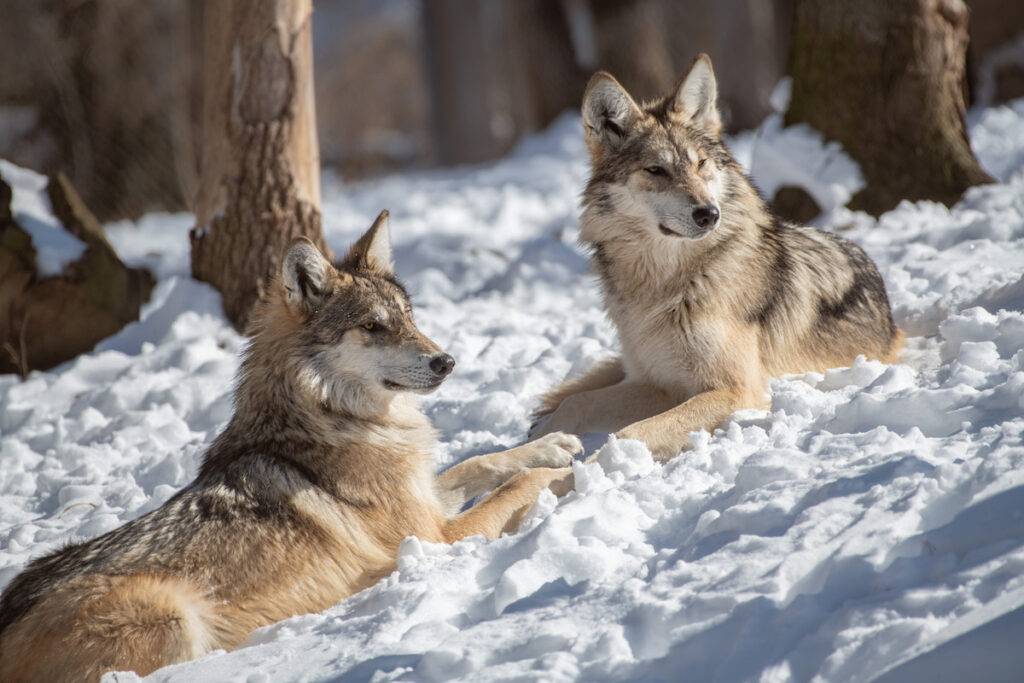
The Endangered Wolf Center is a 501(c)(3) non-profit organization founded in 1971 by the silverback male of early environmentalist television, Mutual of Omaha’s Wild Kingdom host Marlin Perkins.
A major factor in the century-long eradication of many wolf species is the fearful claim that wolves drastically impact livestock. For decades, the data have proved otherwise.
One of the reasons for the Red Wolf’s nearly impossible survivor status is that most people aren’t even aware that the Red Wolf exists. Although human intervention and cooperation can be part of the solution for restoring species in their original ecosystems, we can’t protect a species we’ve never even heard of. (Right?)
A major factor in the century-long eradication of many wolf species is the fearful claim that wolves drastically impact livestock. For decades, the data have proved otherwise. In addition to bounty-hunting, poaching, poisoning, and trapping, the inexorable crawl of habitat loss has been especially deadly for the Red Wolf. Unlike foxes and coyotes, other small canids which may easily be confused with the Red Wolf, Canis rufus is a slender, shy animal that does not adapt easily to human ways. And unlike Coyotes, with which they easily interbreed, Red Wolves have not developed a taste for house cats and city rats, nor have they adapted to eating human garbage. Thus, human expansion and development which wipes out their prey — so-called nuisance species, like raccoons, rabbits, and white-tail deer — wipes out the wolves as well.
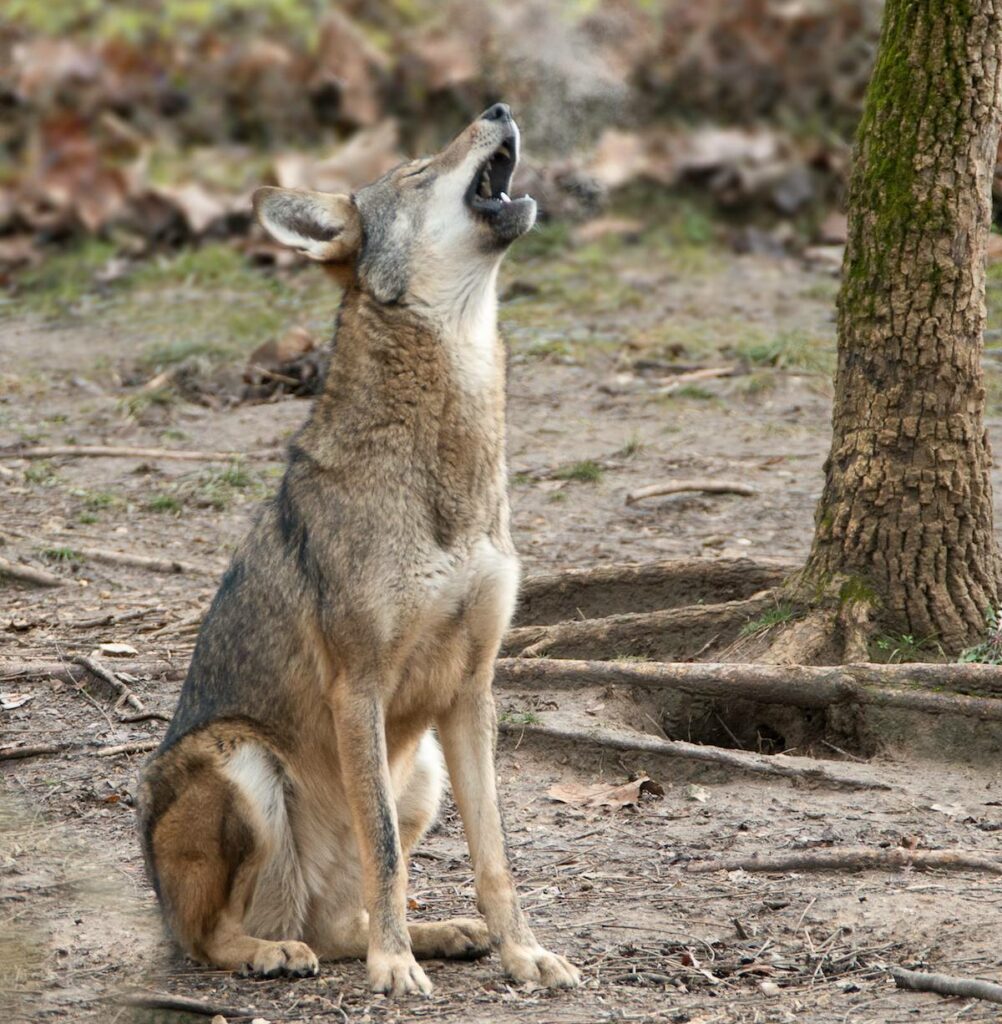
As of October 2022, Holaday explained to me over Zoom, there are 238 American Red Wolves within 47 managed care facilities in the USA, with 11 at the Center in Missouri.
Dedicated to saving canid species from extinction, the Center’s innovative work with another wolf species, the Mexican wolf, entails a delicate bait-and-switch called cross-fostering, where newborn wolf-pups conceived and born in managed care are passed off to a nursing mother in the wild to rear as her own. It's a technique that has also been used with the American Red Wolf in the past.
This strategy may remind bird fanciers of the behavior of the cuckoo, a brood parasite that builds no nest of her own. Ornithologists have recorded the cuckoo mother waiting for the nest’s builder — often a robin or warbler — to briefly depart, then using the opportunity to swoop in and lay one or more of her own eggs in the open nest. To make the ruse work, she’ll often tip out one or more of the host’s eggs or hatchlings to keep the egg-count consistent. The duped bird-parents diligently feed the cuckoo fledglings, which grow freakishly large and eventually fly off.
Pups born in managed care are placed into a wild litter, allowing experienced foster parents to teach them how to thrive in the wild. These pups have an advantage, since they are taught from an early age how to navigate the landscape and hunt successfully.
The wolf pups’ introduction to their foster families is somewhat different. Through the American Red Wolf SAFE cross-fostering program, newborn Red Wolf pups conceived and birthed within managed care facilities are hurriedly introduced into the lair of wild — completely unsocialized, untamed, unused to humans — wolf-parents in North Carolina, the very last scrap of what remains of this wolf’s once-sprawling range.
Note the plural: parents. Understanding this is essential to breaking the wolf code. Male Red Wolves support their mates during pup-rearing, and stick around during the youngsters’ weaning, and long after. In fact, Red Wolves pair-bond monogamously for life, as far as modern researchers can tell. (“There is no divorce court in wolf-world,” Holaday wryly observes.) Pups born from previous litters tend to linger with their parents, too, assisting with catching prey and guarding newborns, although offspring may leave to form their own packs upon maturity when food-supply and territory grow tight.

Strong family ties form the glue of the Red Wolf pack, and this nuclear family configuration is common across the varying sub-species of wolf. This fact negates the hoary concepts of the “lone wolf” (wolves are highly social within their species and subspecies) as mindless eating-machine, and other false descriptives that have followed wolves from old Northern European fairy tales into their near extinction in the modern day.
Holaday says, “Pup fostering is a technique that has been used since 2002 to help boost the genetics and population numbers of the American Red Wolf. Pups born in managed care are placed into a wild litter, allowing experienced foster parents to teach them how to thrive in the wild. These pups have an advantage, since they are taught from an early age how to navigate the landscape and hunt successfully. Additionally, adding pups from different parents into the litter increases the genetic variability of the wild population, which is critical to success.”
Holaday cautions, “As with any conservation technique, there are challenges. In order to be able to foster into the wild, there must be a wild pair that gives birth to a litter, as well as a pair in managed care that gives birth around the same timeframe. When there are fewer than twenty Red Wolves left in the wild, the chances of a female successfully breeding and giving birth are extremely low. That is why adult American Red Wolves have been released in recent years, in addition to fostering.”
But even with Holaday’s caveats, the introduction of the Red Wolf pups into an existing wild litter has been surprisingly successful. In total, 31 pups have been fostered from managed care into wild litters. The most recent Red Wolf foster was completed in 2021 with four pups from the Akron Zoo. (In 2021, two American Red Wolves born and raised at the Endangered Wolf Center were also released as adults into the wild.) At present, none of the introduced pups have been rejected or harmed by their adoptive parents.
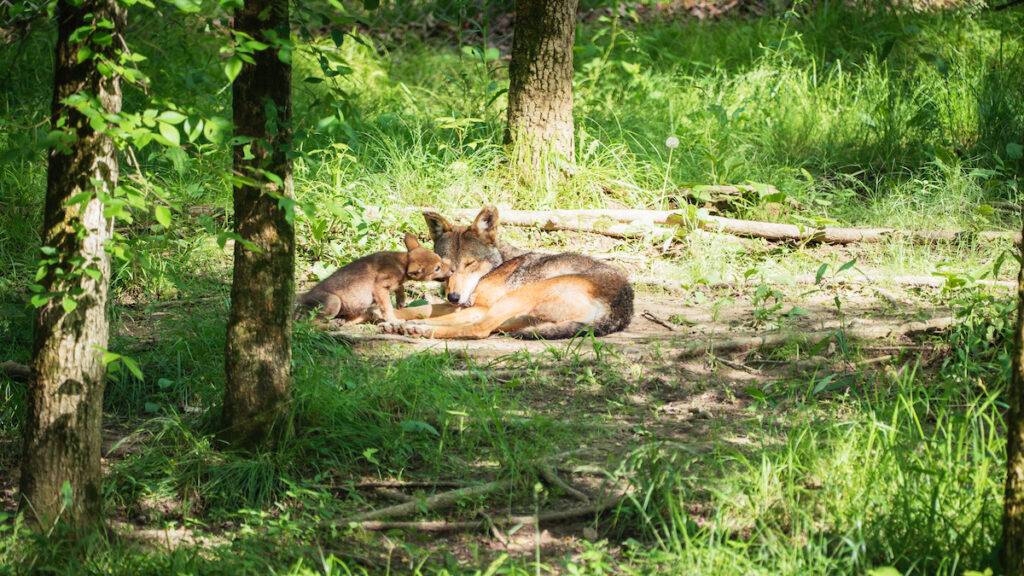
Red Wolves breed once a year between January and March, and discerning pregnancy among Red Wolves in the sanctuary is difficult, as signs are not usually visible until near the end of the two-month gestation period. Mating behavior at the Center is closely observed and immediately flagged, followed by tireless monitoring until pregnancy is certain and the pups are born. A rather brief gestation of 63 days — nine weeks, no more than that of a domesticated cat — offers only a small window for coordination with a corresponding wild pair also about to welcome new pups.
Since puppy season is the same time each year (mid-April to mid-May), the SAFE program works closely with U.S. Fish and Wildlife to determine if any of the potential litters could be fostered into a wild den. A dedicated team of volunteers observes the breeding pairs in human care to get an estimated due date while USFWS monitors the breeding pairs in the wild so that fostering can be timed appropriately. As Holaday says, “The stars have to align.”
Separation of the newborns from their birth-mother underscores the strength of the species’ familial bonds, and well as the wolves’ dogged (sorry!) determination to raise their litters in spite of trauma. Holaday explains, “Traditionally, we don’t take the entire litter. We usually leave two pups for [the birth-mother] to nurse and raise. The Center's wolf parents will run away and ‘alarm-howl’ (a specific type of sharp vocalization used to alert the pack of danger) from a distance while we are pulling pups for fostering. Once we have the pups we are transporting to the wild, our team retreats and keeps noise and human disturbance down to a minimum for the rest of the week. It usually takes less than a couple of hours before the mother will go back to her den and continue nursing the remaining pups.”
Jimmy Parsons, Education Manager for The Endangered Wolf Center, shares the details of the urgent relay process, throughout which handling of the wolves is kept to an absolute minimum, to prevent any softening of the Red Wolf’s natural aloofness: “Newborn pups from a litter in human care are transported to the recovery area on donated private flights with Animal Care and Vet staff on board. While this is occurring, U.S. Fish & Wildlife Service [staff] locate the wild den site, and their presence causes the wild mother and father wolves to leave the area.”

The U.S. Fish & Wildlife Service team then receives the pups born in human care, performs a quick exam on the pups in the wild litter, and then puts all of the pups (both wild and from human care) back into the den, after having dusted the captivity-bred pups with dirt from around the wild mother’s den to camouflage their alien scent. After the humans leave, the wolf mother and father return and will care for all of the pups. U.S. Fish and Wildlife Service personnel also set up trail cameras to monitor the litter and the parents, and hopefully get photos or videos of the pups after they start coming out of the den.
The Endangered Wolf Center’s Jimmy Parsons refers to a days-old Red Wolf pup as “…this cute potato-sized ball of hope, released back into the wild.” The promise and potential heartbreak are palpable. But unlike the adorable stuffed toys on the Center’s website, these animals are not to be cuddled, and it’s essential to their survival that we begin to see them as they truly are: not monsters, not pets, but wild, free, and wholly indifferent to our whims and wishes.
So far, the adoptive wild wolves do not object to humans entering their den, which may surprise anyone who has tangled with a mother animal and her newborns. Even a formerly docile pet may bare tooth and claw when well-meaning humans appear to threaten a litter (a lesson I’ve learned many times from kitten rescue). The wild wolves’ lack of defensive response does not signal lack of loyalty to their pups, but is simply evidence of their true wildness.
Parsons comments, “Wild animals are naturally shy of people. Domesticated animals have lost that instinct, and therefore are more comfortable exhibiting defensive behaviors towards people.”
“The wild pair is not restrained in any way,” he continues. “They run away from the den and stay away until humans leave the area. Wolves hide their den and pups extremely well and therefore hope that interlopers can’t find their den, rather than stay and defend it. Defensive behavior in the wild can lead to wounds which can get infected and become lethal, so it is safer for the parents to run away and come back after the threat has passed.”
Wags may theorize that, like any mother with newborns, the wild mother is just too damn tired to protest the sudden increase in the size of her litter. The joke around the Center is that Red Wolves can’t count. But given the fact that chimps, chickens, cuckoos, and even ants apparently are able to add and subtract (ants actually perform calculations approaching trigonometry), this seems unlikely. More probable: the wild pair simply decides to accept and nurture the outsiders. Those of us who count wolves as ancestors, whether Roman or Eastern Band Cherokee, may anthropomorphize and wonder if this willingness is evidence of the creature’s innate understanding of how dire its future portends to be.
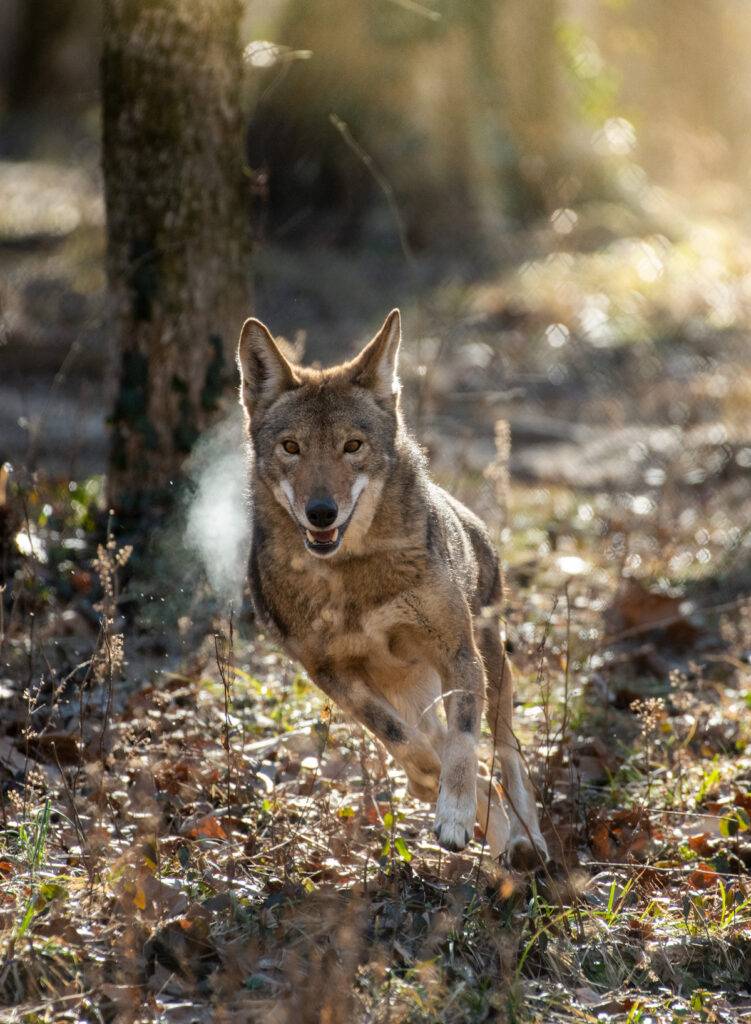
And if the wolf disappears, everything else in the region goes downhill. “The Red Wolf is a keystone species,” Parsons explains. “They represent the point at which so many species interact. If they are removed, the whole ecosystem collapses. Implodes. Herbivores overpopulate and nibble the vegetation down to the dirt. This critical collapse can reduce fertile, complex places to sterile, arid wasteland where only a few remaining species can eke out a survival, a survival which can’t last.”
Regina Mossotti worked with the Endangered Wolf Center prior to accepting her current role as Vice President of Animal Care at the St. Louis Zoo, one of the many organizations that partner with the Center (others include United States Fish & Wildlife Services, Arizona Game and Fish Department, New Mexico Department of Game & Fish, Association of Zoos & Aquariums (AZA), Wolf Conservation Center, and Wolf Haven International).
Via phone call, Mossotti observes, “Wolves are emotionally polarizing, more so than an endangered bird or butterfly or flower. Psychologists might call it a case of projection: everything that we as humans don’t like about ourselves, we project onto wolves.” But bedtime stories of huffing, puffing, red-hooded granddaughter-devouring monsters notwithstanding, Mossotti describes wolves as “scaredy-cats” who fear humans and will go to great lengths to avoid us.
Simply leaving the Red Wolf alone won’t save it. What’s most compelling about the cross-fostering success is that it relies upon the very qualities in a wolf’s personality that generations of hunters, ranchers, farmers, lobbyists, and storytellers contest: loyalty, love, and lupine compassion for seemingly orphaned pups that appear out of nowhere.
Jimmy Parsons refers to a days-old Red Wolf pup as “…this cute potato-sized ball of hope, released back into the wild.” The promise and potential heartbreak are palpable. But unlike the adorable stuffed toys on the Center’s website, these animals are not to be cuddled, and it’s essential to their survival that we begin to see them as they truly are: not monsters, not pets, but wild, free, and wholly indifferent to our whims and wishes. It’s true that the Red Wolf needs us now, but only because of the harrowing damage we’ve inflicted.
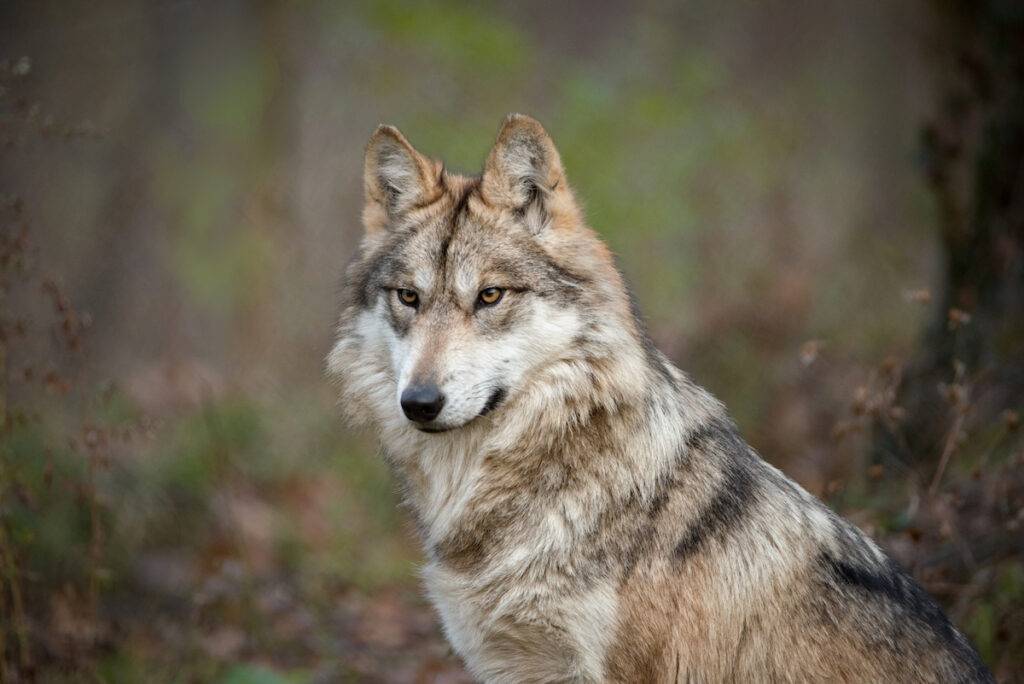
The restoration of wolves in general is good news for ecosystems. The successful 1995 reintroduction of gray wolves into Yellowstone National Park has begun to undo seven decades of damage following the erasure of the original population. Although the ever-opportunistic Coyote quickly rose to the occasion to usurp the crown of the Park’s apex predator, Coyotes are too small and solitary — they rarely hunt in large, efficient packs like wolves — to manage elk, or even adult deer. As a result, the herbivores bred unchecked and ate available vegetation to the ground, leading to a staggering loss of biodiversity across a wide range of taxa.
With wolves back in the ecosystem, plants of all kinds have returned to Yellowstone, attracting essential pollinators. The integrity of the soil has changed for the better, due to the reduction of damage by ungulates. Rivers are returning to their ancient paths once again, allowing for sensitive wildlife (including many varieties of long-absent fish, frogs, snakes, crawfish, snails, muskrats, otters, wild ducks, herons, and the aquatic larvae of dragonflies and damselflies) to flourish once again.
And while the last-minute restoration of this misunderstood and persecuted species is invaluable on its own, perhaps the rescue of the Red Wolf also holds the key to a deeper understanding of our planet, in which even fleas, leeches, and mosquitoes earn their place in the still-emerging portrait of our precious biosphere.


